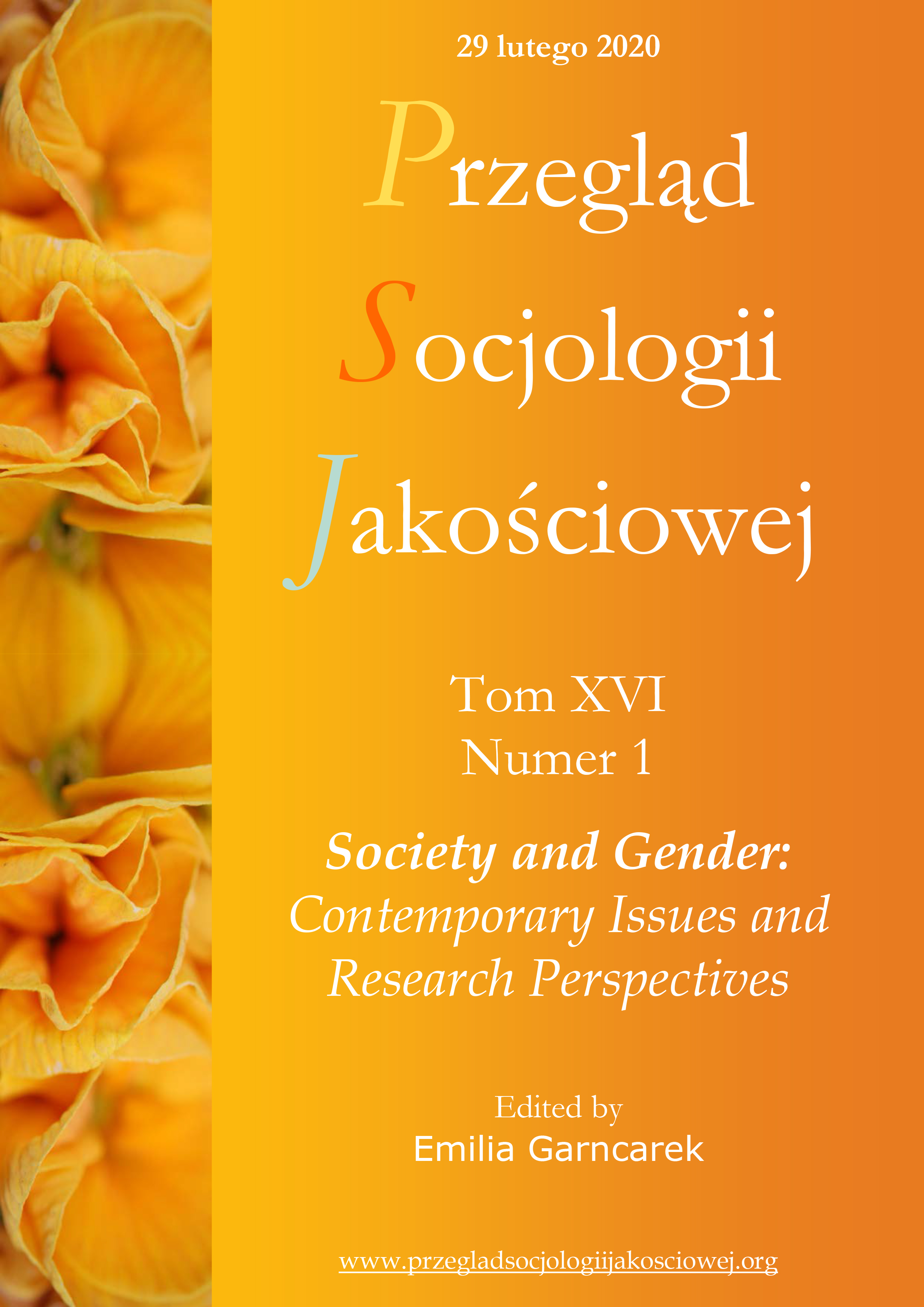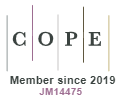Przed lustrem społecznych oczekiwań – doświadczenia kobiet do momentu otrzymania diagnozy niepłodności
DOI:
https://doi.org/10.18778/1733-8069.16.1.05Słowa kluczowe:
niepłodność pierwotna, oczekiwania społeczne, macierzyństwoAbstrakt
Celem artykułu jest przyjrzenie się doświadczeniom kobiet związanym z oczekiwaniami społecznymi dotyczącymi posiadania dzieci. Oczekiwania te wyrażane są poprzez pytania o plany prokreacyjne. Dzięki potraktowaniu doświadczenia prokreacyjnego jako procesu w artykule zrekonstruowano zmiany znaczenia, jakie badane kobiety przypisywały tego typu pytaniom na różnych jego etapach: od etapu przed rozpoczęciem starań o dziecko, poprzez etap początkowy starań o dziecko, etap diagnostyczny, aż do uzyskania diagnozy niepłodności. Kobiety, stojąc przed lustrem społecznych oczekiwań na etapie przed rozpoczęciem przez nie starań o dziecko, widziały w nim swoją przyszłość – siebie w roli matki. Na etapie początkowym starań o dziecko badane dostrzegały w nim swoją bardzo niedaleką przyszłość – siebie w roli kobiety ciężarnej. Na etapie diagnostycznym, aż do uzyskania diagnozy niepłodności, stojąc przed lustrem społecznych oczekiwań, kobiety widziały już tylko swoją niepewną przyszłość – siebie, która bardzo chce, ale nie jest już pewna, czy uda jej się zostać matką.
Pobrania
Bibliografia
Adashi, Eli Y. and Laura A. Dean. 2016. “Access to and use of infertility services in the United States: framing the challenges.” Fertility and Sterility 105(5):1113-1118.
Google Scholar
DOI: https://doi.org/10.1016/j.fertnstert.2016.01.017
Bampton, Roberta, Christopher Cowton, and Yvonne Downs. 2013. “The E-Interview in Qualitative Research.” Pp. 329-343 in Advancing Research Methods with New Technologies, edited by N. Sappleton. Portland: International Science Reference.
Google Scholar
DOI: https://doi.org/10.4018/978-1-4666-3918-8.ch019
Barden-O’Fallon, Janine. 2005. “Associates of self-reported fertility status and infertility treatment-seeking in a rural district of Malawi.” Human Reproduction 20(8):2229-2236.
Google Scholar
DOI: https://doi.org/10.1093/humrep/dei008
Bartosz, Bogna and Katarzyna Bartak. 2011. “Zamierzona bezdzietność wyborem autobiograficznym współczesnych kobiet.” Pp. 275-300 in Wymiary kobiecości i męskości: Od psychobiologii do kultury, edited by B. Bartosz. Warsaw: Wydawnictwo Eneteia.
Google Scholar
Bohnsack, Ralf. 2001. “Dokumentująca interpretacja wzorów orientacji działania.” Pp. 170-189 in Jakościowe orientacje w badaniach pedagogicznych: studia i materiały, edited by D. Urbaniak-Zając and J. Piekarski. Lodz: Wydawnictwo Uniwersytetu Łódzkiego.
Google Scholar
Budrowska, Barbara. 2000. Macierzyństwo jako punkt zwrotny w życiu kobiety. Wroclaw: Fundacja Na Recz Nauki Polskiej.
Google Scholar
Budrowska, Barbara. 2003. “Znikoma reprezentacja kobiet w elitach – próby wyjaśnień.” Pp. 39-67 in Szklany sufit. Bariery i ograniczenia karier kobiet. Monografia zjawiska, edited by A. Titkow. Warsaw: ISP.
Google Scholar
Cieślińska, Barbara. 2014. “Bezdzietność jako styl życia.” Pogranicze. Studia Społeczne 24:277-292.
Google Scholar
DOI: https://doi.org/10.15290/pss.2014.24.15
Daniluk, Judith C. 2005. “Reconstructing their lives: a longitudinal, qualitative analysis of the transition to biological childlessness for infertile couples.” Journal of Counseling & Development 79(4):439-449.
Google Scholar
DOI: https://doi.org/10.1002/j.1556-6676.2001.tb01991.x
Dick, M-L. B. et al. 2003. “Self-reported difficulty in conceiving as a measure of infertility.” Human Reproduction 18(12):2711-2717.
Google Scholar
DOI: https://doi.org/10.1093/humrep/deg504
Dzwonkowska-Godula, Krystyna. 2009. “Macierzyństwo i ojcostwo jako nowe doświadczenie kobiety i mężczyzny.” Acta Universitatis Lodziensis. Folia Sociologica 34:107-125.
Google Scholar
Earle, Sarah and Gayle Letherby. 2002. “Whose choice is it anyway? Decision making, control and conception.” Human Fertility 5(2):39-41.
Google Scholar
DOI: https://doi.org/10.1080/1464727022000198892
Garncarek, Emilia. 2009. “Kobieta bez dziecka vs. mężczyzna bez dziecka w świetle wypowiedzi autorów postów internetowych.” Acta Universitatis Lodziensis Folia Sociologica 34:127-140.
Google Scholar
Gerhardt, Utha. 1989. Ideas about Illness. An Intellectual and Political History of Medical Sociology. New York: New York University Press.
Google Scholar
Gibson, Donna M. and Jane E. Myers. 2000. “Gender and Infertility: A Relational Approach to Counseling Women.” Journal of Counseling & Development 78:400-410.
Google Scholar
DOI: https://doi.org/10.1002/j.1556-6676.2000.tb01923.x
Greil, Arthur L., Julia McQuillan, and Kathleen Slauson-Blevins. 2011. “The social construction of infertility.” Sociology Compass 5(5):736-746.
Google Scholar
DOI: https://doi.org/10.1111/j.1751-9020.2011.00397.x
Greil, Arthur L., Kathleen Slauson-Blevins, and Julia McQuillan. 2010. “The experience of infertility: a review of recent literature.” Sociology of Health & Illness 32(1):140-162.
Google Scholar
DOI: https://doi.org/10.1111/j.1467-9566.2009.01213.x
Hampshire, Katherine R., Mwenza T. Blell, and Bob Simpson. 2012. “‘Everybody is moving on’: Infertility, relationality and the aesthetics of family among British-Pakistani Muslims.” Social Science & Medicine 74(7):1045-1052.
Google Scholar
DOI: https://doi.org/10.1016/j.socscimed.2011.12.031
Holter, H.et al. 2006. “First IVF treatment – short-term impact on psychological well-being and the marital relationship.” Human Reproduction 21(12):3295-3302.
Google Scholar
DOI: https://doi.org/10.1093/humrep/del288
Huang, J. Y. J. et al. 2003. “Internet use by patients seeking infertility treatment.” International Journal of Gynecology & Obstetrics 83(1):75-76.
Google Scholar
DOI: https://doi.org/10.1016/S0020-7292(03)00253-4
Jacobson, Melanie H. et al. 2018. “Research on Infertility: Definition Makes a Difference” Revisited.” American Journal of Epidemiology 187(2):337-346.
Google Scholar
DOI: https://doi.org/10.1093/aje/kwx240
Jaguś, Inga. 2005. “Od wielodzietności do bezdzietności? Przemiany w poglądach na posiadanie dzieci i ich uwarunkowania.” Roczniki Socjologii Rodziny 16:127-139.
Google Scholar
Janicka, Anna, Robert Z. Spaczyński, and Rafał Kurzawa. 2015. “Assisted reproductive medicine in Poland – Fertility and Sterility Special Interest Group of the Polish Gynaecological Society (SPiNPTG) 2012 report.” Ginekologia Polska 86(12):932-393.
Google Scholar
Johnson, Katherine M. and Jasmine Fledderjohann. 2012. “Revisiting ‘her’ infertility: Medicalized embodiment, self-identification and distress.” Social Science & Medicine 75(5):883-891.
Google Scholar
DOI: https://doi.org/10.1016/j.socscimed.2012.04.020
Johnson, Katherine M. et al. 2019. “Infertility and Self-identification: The Indeterminacy of the Illness-self Relationship.” Sociological Perspectives, p. 1-18. Retrieved November 12, 2019 https://journals.sagepub.com/doi/abs/10.1177/0731121419867691?jour¬nalCode=spxb
Google Scholar
Łepecka-Klusek, Celina, Anna B. Pilewska-Kozak, and Grzegorz Jakiel. 2012. “Niepłodność w świetle definicji choroby podanej przez WHO.” Medycyna Ogólna i Nauki o Zdrowiu 18(2):163-166.
Google Scholar
Łukaszuk, Krzysztof et al. 2018. “Diagnostyka i leczenie niepłodności — rekomendacje Polskiego Towarzystwa Medycyny Rozrodu i Embriologii (PTMRiE) oraz Polskiego Towarzystwa Ginekologów i Położników (PTGP).” Ginekologia i Perinatologia Praktyczna 3(2):112-140.
Google Scholar
Marino, Jennifer L. et al. 2011. “Fertility treatments and the young women who use them: an Australian cohort study.” Human Reproduction 26(2):473-479.
Google Scholar
DOI: https://doi.org/10.1093/humrep/deq305
Meho, Lockman I. 2006. “E-Mail Interviewing in Qualitative Research: A Methodological Discussion.” Journal of American Society for information Science and Technology 57:1284-1295.
Google Scholar
DOI: https://doi.org/10.1002/asi.20416
Morgan, Stephanie J. and Gillian Symon. 2004. “Electronic interviews in organizational research.” Pp. 23-33 in Essential Guide to Qualitative Methods in Organizational Research, edited by C. Cassel and G. Symon. London, Thousand Oaks, New Delhi: Sage Publications.
Google Scholar
DOI: https://doi.org/10.4135/9781446280119.n3
O’Connor, Henrietta and Clare Madge. 2008. “Online Interviewing.” Pp. 271-288 in The SAGE Handbook of Online Research Methods, edited by N. Fielding, R. M. Lee, and G. Blank. Los Angeles, London, New Delhi, Singapore: Sage Publications.
Google Scholar
Przybył, Iwona. 2003. “Naznaczanie społeczne i samonaznaczanie osób niepłodnych.” Blaski i cienie życia rodzinnego. Roczniki Socjologii Rodziny 15:47-61.
Google Scholar
Radkowska-Walkowicz, Magdalena. 2013. Doświadczenie in vitro: niepłodność i nowe technologie reprodukcyjne w perspektywie antropologicznej. Warsaw: Wydawnictwo Uniwersytetu Warszawskiego.
Google Scholar
DOI: https://doi.org/10.31338/uw.9788323513032
Ratislavova, Kateřina and Jakub Ratislav. 2014. “Asynchronous email interview as a qualitative research method in the humanities.” Human Affairs 24:452-460.
Google Scholar
DOI: https://doi.org/10.2478/s13374-014-0240-y
Rawal, N. and N. Haddad. 2005. “Use of internet in infertility patients.” The Internet Journal of Gynecology and Obstetrics 5(2):1-5.
Google Scholar
Sandelowski, Margarete, Diane Holditch-Davis, and Betty G. Harris. 1990. “Living the life: explanations of infertility.” Sociology of Health & Illness 12(2):195-215.
Google Scholar
DOI: https://doi.org/10.1111/1467-9566.ep11376477
Sikorska, Małgorzata. 2016. “‘Prywatne’ i ‘publiczne’ konteksty macierzyństwa oraz rozrodczości – analiza dyskursu publicznego.” Societas/Communitas 21:137-156.
Google Scholar
Skrzypek, Michał. 2011. Perspektywa chorego w socjologii choroby przewlekłej. Lublin: Wydawnictwo Katolickiego Uniwersytetu Lubelskiego.
Google Scholar
Slany, Krystyna and Izabela Szczepaniak-Wiecha. 2003. “Bezdzietność czy nowa wartość we współczesnym świecie.” Pp. 159-169 in Systemy wartości a procesy demograficzne, edited by K. Slany and I. Szczepaniak-Wiecha. Cracow: Zakład Wydawniczy NOMOS.
Google Scholar
Sokołowska, Magdalena. 1986. Socjologia medycyny. Warsaw: Państwowy Zakład Wydawnictw Lekarskich.
Google Scholar
Talarczyk, Joanna et al. 2012. “Internet jako źródło informacji o niepłodności wśród niepłodnych pacjentek.” Ginekologia Polska 83:250-264.
Google Scholar
Tomaszewska, Joanna. 2017. “‘Childfree?’: praktyki dyskursywne osób bezdzietnych z wyboru w Polsce.” Tematy z Szewskiej 2(19):67-84.
Google Scholar
van Balen, Frank and Marcia Inhorn. 2002. “Interpreting Infertility: A View for The Social Science.” Pp. 3-32 in Infertility around the globe: new thinking on childlessness, gender, and reproductive technologies, edited by M. Inhorn and F. van Balen. Berkeley, Los Angeles, London: University of California Press.
Google Scholar
Weissman, Ariel et al. 2000. “Use of the Internet by infertile couples.” Fertility and Sterility 73(6):1179-1182.
Google Scholar
DOI: https://doi.org/10.1016/S0015-0282(00)00515-X
Pobrania
Opublikowane
Jak cytować
Numer
Dział
Licencja

Utwór dostępny jest na licencji Creative Commons Uznanie autorstwa – Użycie niekomercyjne – Bez utworów zależnych 4.0 Międzynarodowe.














